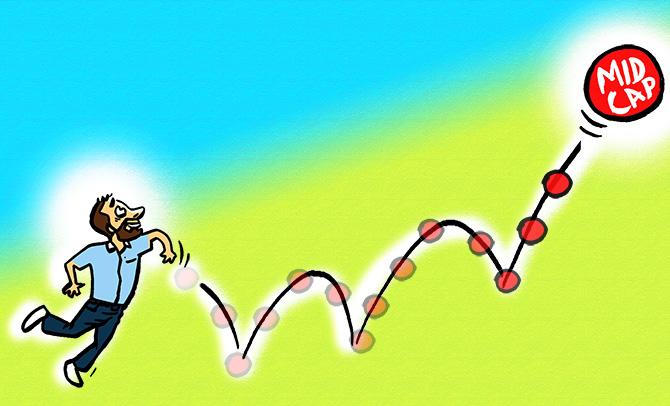BSE small-cap index hits new intra-day high, holds out hope
The current up move, according to analysts, closely resembles the rally post the global financial crisis in 2008-09, not just in quantum and speed, but also the way small-and mid-cap indices outperformed large-cap peers.
Illustration: Dominic Xavier/Rediff.com.
Despite the sharp outperformance on a year-to-date (YTD) basis, analysts believe small- and mid-cap stocks still have more steam left.
Though there can be an intermittent correction, stock selection will be the key, they say.
The optimism stems from the better-than-expected rebound in economic activity after a stringent lockdown for a few months in 2020 coupled with efficacy of the Covid vaccine.
On Friday, the S&P BSE Small-cap index hit a new high of 21,411, up 1 per cent on the BSE in intra-day trade as power, textiles, jewellery, industrial machinery, chemicals and packaging stocks surged.
The index surpassed its previous high of 21,389, hit on March 3, 2021.
The current up move, according to analysts at Edelweiss Securities, closely resembles the rally post the global financial crisis in 2008-09, not just in quantum and speed, but also the way small-and mid-cap indices outperformed large-cap peers.
“During November 2008-December 2009, Nifty, Mid-cap 100 and Small-cap 100 had rallied 90 per cent, 125 per cent and 132 per cent, respectively. This time, these indices rallied 100 per cent, 114 per cent and 140 per cent, respectively. For small-and mid-cap indices, during both the periods, valuations have doubled,” wrote Aditya Narain, head (research) for institutional equities at Edelweiss Securities in a recent report. The report was co-authored with Alok P Deshpande and Sameer Chuglani.
Another key factor that has aided the sharp rally, especially in the mid-cap segment, is the ample liquidity with global central banks remaining in an ‘accommodative’ mode. That apart, retail investors have latched on to this market segment over the past one year in a bid to make a quick buck, said analysts. With the economy opening up, companies, too, are back in business and the demand for products is steady. All this augurs well for companies, especially in the mid-and small-cap space.
Historically, a phase of disruption has been followed by outperformance in mid-cap and small-cap indices (in years 2009, 2016 and 2017). The trend has continued with both the indices outperforming the Nifty50 in CY20 and YTD in CY21, data shows.
The recent rally in some of the individual stocks has been sharper. On a YTD basis, Adani Enterprises, IDFC First Bank, Adani Transmission, Cummins India and BHEL have gained 52 per cent to 88 per cent, ACE Equity data shows.
Valuation concerns
Analysts do caution against the valuation at which these indexes and some of the stocks are trading at. Besides, rising commodity prices, inflation and bond yields remain key risks for the markets.
The Nifty mid-cap index has sharply rebounded by over 70 per cent since June 2020 and is now trading at 24x forward price-to-earnings (PE). This, analysts at Jefferies say, is 29 per cent and 53 per cent premium to its 5-year and 10-year historical average, respectively.
“We recommend a bottom-up stock picking approach in small and mid caps. Earnings growth in this universe could be aided by cyclical recovery in property, electrodes, autos, select industrials and health care stocks. Average return on equity (RoE) is likely to expand by 520 basis points (bps) to 19.2 per cent by FY23 (14 per cent in FY21), with better profitability. Key growth catalysts could be government initiatives, housing revival, market share gains, indigenisation, new product launches and balance sheet strength,” said Sonali Salgaonkar, an analyst tracking the mid and small cap segment at Jefferies.
Source: Read Full Article


